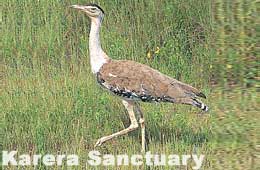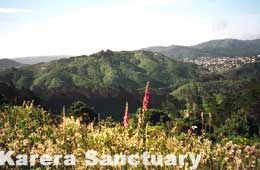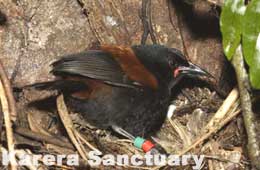|
The Karera Sanctuary is home of the Great Indian Bustard and the equally snooty blackbuck.

The Karera Bird Sanctuary is located in the central Indian state of Madhya Pradesh near the Madhav National Park. There are many other varieties of birds and animals found here. The Dihaila Jheel here plays host to many migratory birds.
The status of the Karera is that of the Great Indian Bustard Sanctuary and it was notified in 1981 as a sanctuary. The vegetation is reverie and swamp with mixed deciduous forests. Ber bushes and other wild plants are found in abundance. There are no trees except acacia throughout this forest.
The region around Karera is quite dry and rocky but one can feel more relaxed at the Dihaila Jheel. Entirely rainfed, the size and depth of the lake depend on the monsoons. Across the waters lay Dihila village whose inhabitants own and use the land forming the lakebed and whose crops have benefited from the gauano deposite of the birds.
While gazing across the tranquil blue water you can see that the migratory ducks had already settled in. Other birds like Pintail, wigeon, teal, and gadwall snooze in the sun or squat meditatively in the mud. Black bellied and river terns patrol the water in their laconic manner, while egrets hunt craftily in the shallows. On the huge rock formations near the edge of the lake, you can see the larks squatting quietly while the Indian robins, in their natty blue-black and russet, stake out their territories with song.
 The town of Shivpuri is situated at a distance of 55 km from Karera.The place still maintains its old world charm. Its royal past still lives in the form of its majestic palaces, hunting lodges, and exquisitely adorned chhatris (cenotaphs) built by the Scindia's. The Karera Bird Sanctuary is located in the central Indian state of Madhya Pradesh.
The town of Shivpuri is situated at a distance of 55 km from Karera.The place still maintains its old world charm. Its royal past still lives in the form of its majestic palaces, hunting lodges, and exquisitely adorned chhatris (cenotaphs) built by the Scindia's. The Karera Bird Sanctuary is located in the central Indian state of Madhya Pradesh.
Avifauna, there are many migratory birds that settle here in the season. In fact, experts have recorded a total of 245 bird species in Karera. There are pintails, teals, and gadwalls snoozing in the sun or squatting meditatively in the mud. There are resident water birds too like the black-bellied river terns, egrets, and spoonbills. Other birds found here are herons, Indian robins, as also insects like dragonflies, damselflies, and butterflies.
Karera is one of the last refuges of the great Indian bustard. As per expert studies, one can find three types of bustards thrive here, the Indian bustard, bearded bustard, and colored bustard.
The blackbuck and Indian gazelle are the prominent habitants of this open country. Here, out in the thorny open country, the blackbucks seem terribly vulnerable. Due to problems of grazing and subsequent crop loss, the locals started killing the blackbucks, but after rigorous protection measures by the sanctuary guards and efforts of environmental friendly organizations, the number of blackbucks here has been consistently increasing. Now, the blackbuck population in the sanctuary numbers at around 2000, a considerable increase from the lowly 100 in 1981.
Dihaila Jheel (lake) in the Karera Sanctuary is the only water source for its inhabitants. Entirely rain fed, the size and depth of the lake depend on the monsoons each year. Across the waters lies the Dihaila village whose inhabitants own and use the land forming the lakebed and whose crops have benefited from the guano deposits of the birds.
Fact File:
Getting There: Gwalior at a distance of 150 from Karera is the nearest airport. There are regular flights from Gwalior to Mumbai, Delhi, and Indore.
Jhansi at a distance of around 44 km off Karera is the nearest railway station. Jhansi is a major railway hub connected to Delhi, Mumbai, Calcutta, Chennai and many more cities in India by several good trains.
 Karera is connected to Shivpuri and Jhansi by regular buses. It is also connected to Gwalior and other important cities in the region by a good road network.
Karera is connected to Shivpuri and Jhansi by regular buses. It is also connected to Gwalior and other important cities in the region by a good road network.
Accommodation: Rest houses are available within the park area. One can also stay at Jhansi or Shivpuri where good accommodation options are available. We offer excellent accommodation facilities around Karera Sanctuary.
Climate: The climate of this region is tropical as in the other places in the Indian plains. April to mid July are the hottest months. Monsoon reaches this region in July and remains in force till mid September. Winter months are November to February. The best season to visit this region is winter.
|